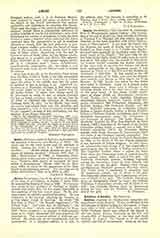

Amida (DIARBEKIR), the Diocese of (Armenian Rite) in Mesopotamia, Asiatic Turkey.—The foundation of the city of Amida has been wrongly attributed to Tigranes I, or Tigranes III (the Great), Kings of Armenia; it has been identified with either Tigranocerte or Dikranagherd. It got from the Greeks and the Romans the name of Amida, and is known in Turkish as Kara-Amid, i.e. “Amida the Black,” but goes more generally by its Arabic name of Diarbekir (Land of the Virgin). The town rises on the left bank of the Tigris, about 75 miles from its source and about 900 miles from the mouth of that river. An interior citadel overlooks the double enclosure of the town with its seventy-two towers, and dates back undoubtedly to the Armenian epoch; it was repaired by Valens (A.D. 364-378) and was finished by Anastasius I (491-518). In this citadel is the old Byzantine church of St. John, now used for Mussulman worship, and known as Olou Djami, the Long Mosque. In 638, Amida was taken by the Arabs who called it Diarbekir. Later on it passed under Persian domination. Since 1514 it belongs to the Ottoman empire and is the chief city of the vilayet of the same name, It has about 35,000 inhabitants, of whom 20,000 are Mussulmans (Arabians, Turks, Kurds, etc.), 2,300 Catholics (Chaldeans, Armenians, Syrians, Melchites, Latins), 8,500 Gregorian Armenians, 900 Protestant Armenians, 950 Jacobite Syrians, 900 Orthodox Greeks, and 300 Jews. Diarbekir possesses an Armenian Catholic bishop, a Syrian Catholic bishop, a Syrian Jacobite bishop, a Chaldean Catholic archbishop, and a Greek Orthodox metropolitan under the jurisdiction of the Patriarch of Antioch. The Latin Mission of Diarbekir, founded by Pere Jean-Baptiste de Saint Aignan (1667), remained in the hands of the French Capuchins during nearly a century and a half. Its founder converted (1671) the Nestorian Bishop Joseph, with whom Innocent XI inaugurated (1681) the series of the Chaldean Catholic patriarchs. The mission suffered much during the French Revolution. In 1803, at the death of the last French Capuchin, it was entrusted to Italian religious. In 1841, Spanish missionaries took charge of it, but eventually it passed again into the hands of Italian missionaries. The Capuchin Fathers direct a school for boys. Near them the Franciscan nuns of Lons-le-Saunier have opened (since 1882) a school for girls. An American Protestant mission, working especially among the Armenians, keeps up three schools: two for boys and one for girls. Besides these foreign establishments Diarbekir possesses fifty-four others. The Turks have 4 medresses, 3 secondary and 33 elementary schools, one of which is for girls. The Gregorian Armenians have 5 elementary schools, one of which is for girls. The Catholic Armenians have an elementary school for boys, the Catholic Chaldeans 3 elementary schools, one of which is for girls. The Catholic Syrians have an elementary school for boys, and the Israelites an elementary school for girls.
S. PETRIDES

